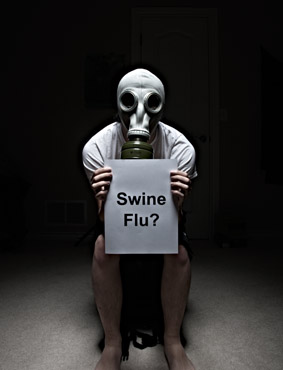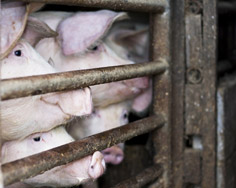Who's Afraid of the Swine Flu?
Article published: Thursday, November 19th 2009
Media hype has infected many with swine flu fatigue. But the current pandemic poses a very real danger to human health, one which raises serious questions about the modern industrial farms that ‘fast track’ the evolution of viruses dangerous to people.
 The World Health Organization has declared a global pandemic of a new strain of influenza virus (novel H1N1 or swine flu). The problem sparked much initial fear and drew extensive media attention. However, most illness is mild and there is no evidence thus far that this flu is any more lethal than regular seasonal flu. So what’s all the fuss about?
The World Health Organization has declared a global pandemic of a new strain of influenza virus (novel H1N1 or swine flu). The problem sparked much initial fear and drew extensive media attention. However, most illness is mild and there is no evidence thus far that this flu is any more lethal than regular seasonal flu. So what’s all the fuss about?
The short answer is that it could get a lot worse – experts have the devastating Spanish flu pandemic in mind, which killed 50 million people in 1918. Viruses will always be with us, but the emergence of modern methods of industrial farming poses a new kind of threat.
What’s a virus?
Viruses contain little bits of genetic material that require animal hosts to reproduce. All flu epidemics are associated with type A influenza, which is naturally carried by wild birds. Influenza A contains eight discrete chunks of genetic material, which can either mutate bit by bit (referred to as ‘drift’) or ‘shift’ all of a sudden.
Recently, viral evolution seems to have accelerated with the emergence of ‘triple reassortment’ viruses, like swine flu, so-called because they include genetic material from pigs, birds and humans.
The introduction of viruses like these, to which the human population has not been previously exposed is dangerous because the human immune system carries no resistance – reactions can be dramatic and even lethal. This is what happened with the Spanish flu and is feared in the current pandemic: the healthy young are disproportionately affected. Novel viruses such as these tend not to spread easily from one person to another. But it is an ‘odds game’: the more such viruses emerge, the greater the chance that one, like the current one, will be transmissible between humans.
Industrial Farms, a breeding ground for viral reassortment
The town that became home to the first human case of today’s swine flu was near a Smithfield industrial farm and under the cinched belt of the North American Flyway bird migration route, a good setup for interspecies viral mixing.
Hogs are relatively easily infected by viruses from other species (such as birds and people), serving as ‘mixing vessels’ for new viruses. ‘In fact, Triple re-assortment’ viruses were first identified among pigs on North American industrial farms in the late 1990s.
Factory farms force feed large numbers of animals kept in small areas, increasing opportunities for pathogen transmission. Smithfield’s Mexican outfit raises 950,000 pigs per year.
Swine also produce vast amounts of excrement that industrial farms store in open air ‘lagoons’, which hold up to 25 million gallons. To save costs, the plant use water from lagoons for cleaning hog barns, which is dangerous to public health as it introduces bird faeces and viruses.
The 1990s saw a rise in numbers of industrial farms and a rash of animal-to-human viral outbreaks. However, this is the first time a ‘triple reassortment’ virus rapidly spread between humans.
On the industrial farms, human workers are exposed to thousands of animals daily. Add extensive movement of people, swine, poultry and foodstuffs to the mix and it is clear that risks of viral evolution and transmission are extraordinarily increased by modern factory farming.
Cover ups and Collusion
Although the first patient to contract swine flu in the current epidemic lived near a Smithfield industrial pig farm in Veracruz, Mexico, local officials’ first reaction was to offer reassurances rather than inspections.
 Corporate owners of the farm, who had historically avoided public inspections, gave the state minimal biological evidence – 30 snout swabs – that ‘proved’ the emergence of a swine-origin virus near their farm was simply a ‘coincidence’.
Corporate owners of the farm, who had historically avoided public inspections, gave the state minimal biological evidence – 30 snout swabs – that ‘proved’ the emergence of a swine-origin virus near their farm was simply a ‘coincidence’.
Smithfield is the world’s largest pork producer. They have been fined repeatedly in the US for improper waste handling and found to have intentionally lied to federal regulators. But they are powerful and have real influence: a 1995 Pulitzer-prize winning investigation uncovered how Smithfield effectively controlled the North Carolina state senate. They also tried to cover up a previous swine flu epidemic in a Romanian pig farm in 2008. Armed guards turned away government inspectors while official spokesmen offered reassurances.
The Avian flu outbreak provided more examples of governmental and industry collaboration in epidemic cover ups of previous influenza outbreaks in countries like Thailand, S. Korea, Japan, Cambodia, Laos and Indonesia; well-documented by Mike Davis in his book ‘The Monster at Our Door: The Global Threat of Avian Flu’.
Pandemic preparedness
Scientists and the public health community have long been calling for work on pandemic preparedness. However the Bush administration spent more money on ‘abstinence education’ than pandemic preparedness and diverted infectious disease resources to “combating bio-terrorism”.
Experts warn that swine flu may become more virulent this winter. Hopefully, the worst predictions will prove alarmist. Nonetheless, the public is ill-served not to appreciate the lethal potential of the first human-to-human transmission of a ‘species jumping’ virus and the special role played by industrial farming. The time to heed calls for surveillance of industrial animal farming is long overdue.
Laura S. Boylan, MD is Clinical Associate Professor of Neurology at New York University School of Medicine.
More: Features
Comments
No comments found
The comments are closed.



